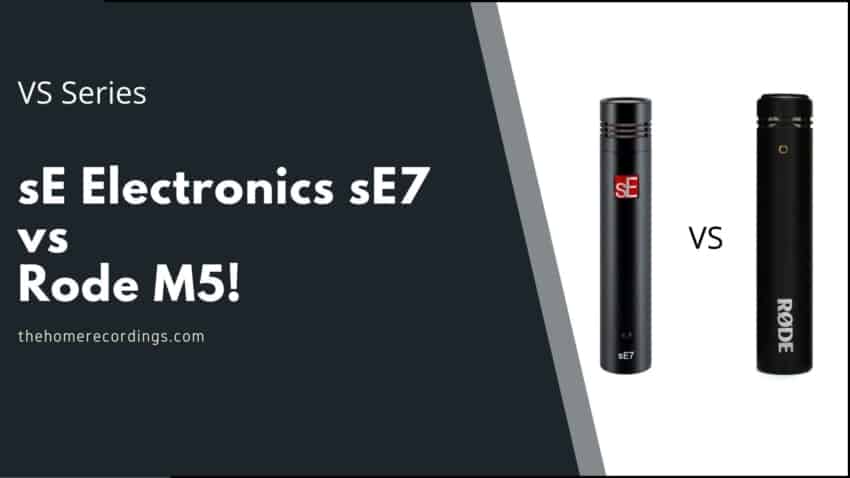Last updated on December 29th, 2023 at 09:56 pm
The sE7 and the M5 are two very similar small diaphragm condenser microphones that compete in both price and sound quality, with the sE7 having a couple additional features.
In this article, I will be comparing the two, giving you a complete overview of their features, or lack thereof, and at the end I will give you my opinion on which one you should go for depending on your needs.
In short; Both are small diaphragm condenser microphones with a cardioid polar patter, but the sE7 features a -20dB PAD, useful when recording loud sources, and a high pass filter, to help you control the lower frequencies. Soundwise, the sE7 has a better sounding low-end, but the boost to the higher frequencies makes it sound harsher than the M5.
Let’s get into the specifics now!
sE Electronics sE7
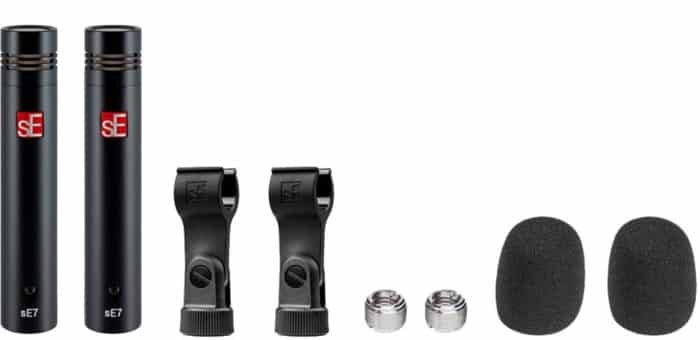
The sE7 is a small diaphragm condenser microphone with a cardioid polar pattern that comes housed in a black all-metal body that looks and feels very sturdy, and you can buy a single one or a matched pair.
While getting a pair is definitely not as affordable as buying something like the Samson C02, these microphones are a definite step up from the usual budget condenser pencil microphones, and replacing them won’t probably be required in the future, which is why I generally recommend going for something a bit more expensive, since you’ll end up saving money in the long run.
In terms of features, the sE7 offers a -20dB PAD to help you attenuate extremely loud sound sources and still get a great quality signal, allowing you to record sources of up to 156dB (with the PAD engaged), and a 6dB/octave high pass filter at 80Hz to help you avoid low-end rumble.
Most small diaphragm condenser microphones in this price range don’t offer neither the PAD nor the HPF, which is one of the huge pros about the sE7 since having these features can make recording a lot easier.
Aside from that, there isn’t anything noteworthy about the sE7 since it’s a fairly simple microphone that does what it’s supposed to.
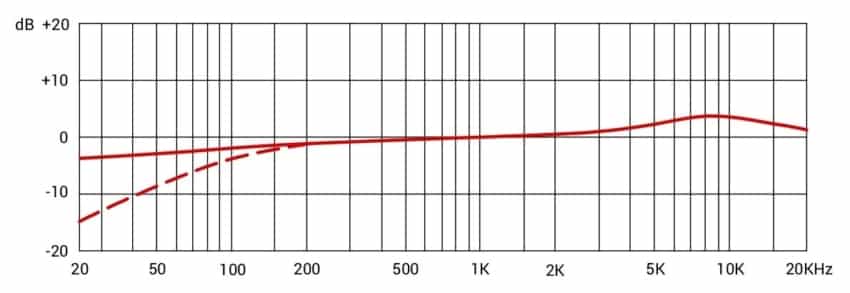
In terms of the frequency response, just like most small diaphragm condensers, the sE7 picks up sound from 20Hz to 20kHz, the frequency response itself is pretty flat with a bump around the 10kHz mark (between 3kHz-18kHz) and a slight bass roll off, and in this image, you can see how engaging the HPF will affect the bass response of this mic.
Lastly, the sE7 requires 48v of phantom power to work.
How does it sound?
As far as sound quality goes, I really liked it when recording spoken word/singing and acoustic guitar.
It has a nice and balanced low end without sounding too boomy (Important Note: For spoken work or singing I would highly suggest engaging the HPF and using a pop filter, since plosives with this mic are going to be a BIG issue otherwise).
The mids sound phenomenal, in the sense that there are no frequencies that are popping their heads out in any drastic way, and this should keep you from automatically reaching for an EQ as soon as possible.
Now to the high end: The boost to the higher frequencies I find to be both a good and a bad thing; Good because when recording acoustic guitar, for example, it opens up the sound and just makes it a lot more airy sounding.
However, I found that added boost somewhat bad when recording overheads, for example, since it makes the cymbals sound shrill.
Of course, this depends on your taste, but I prefer the sE7 mostly on an acoustic guitar, or piano even, but not so much on overheads.
What comes in the box?
- sE Electronics sE7 Microphone
- Microphone clip
- Mic stand adapter
- Pop Filter (not enough for spoken word)
Specifications
| Microphone Type | Small diaphragm condenser |
| Polar Pattern | Cardioid |
| Frequency Response | 20Hz – 20kHz |
| Output Impedance | 200Ω |
| Maximum SPL | 136dB SPL, 156dB (with pad) |
| Sensitivity | -34.5dB |
| Self-Noise | 16dB |
Find out more about the sE Electronics sE7 here:
- sE Electronics sE7: Amazon, Sweetwater.
Rode M5
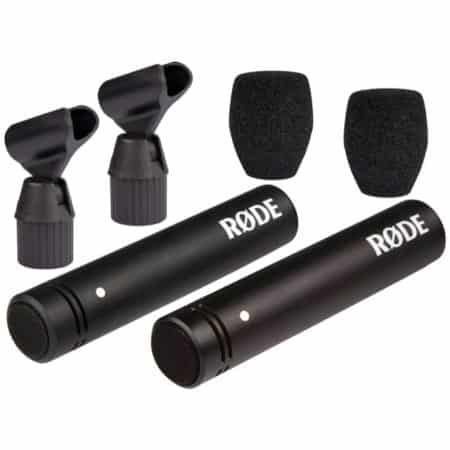
The Rode M5 is a small diaphragm condenser pencil style microphone that features a compact and light design with a sleek and strong black-matte ceramic coating.
Contrary to some other small diaphragm condenser microphones out there, the M5 only sells as a matched pair, and the M5 matched pair sells for exactly the same as the sE7 matched pair.
The M5 comes with a WS5 pop filter and a RM5 stand mount, which should help you keep those pesky plosives at bay. However, when recording spoken word or singing, please consider placing a real pop filter in front of it.
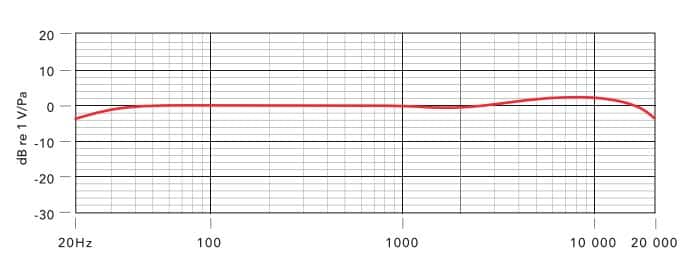
It captures a full frequency response range of 20Hz to 20kHz using a cardioid pickup pattern and it features a small boost in the 7kHz-16kHz range and it slightly pulls back around 20Hz-40Hz and around 18kHz.
The M5 requires +48v of phantom power to work, which luckily, most audio interface do provide.
Lastly, the Rode M5 doesn’t come with a PAD or a High-Pass filter.
How does it sound?
The Rode M5 pair excels in the mid and high frequencies in my opinion, since it doesn’t sound shrill or add any harshness or crispiness to the sound while still sounding open and airy, which is why it works great with guitars, percussion (especially overheads), strings, woodwinds, brass, pianos, and other similar instruments, as well as choirs.
However, one thing to note is that the M5 lacks a bit of presence in the bottom end which might leave the recording sounding a bit too thin.
Of course, this depends on the situation and what the mix requires, since you usually will remove some of that low end regardless when mixing loads of different tracks.
Small diaphragm condensers are known for having a very flat frequency response, which means that they take a pretty accurate snapshot of your sound without adding too much low-, mid-, or high-end.
As far as recording singing/spoken word goes, I have to say that I generally prefer large condensers for this specific job, however, the M5 does capture singing extremely well!
What comes in the Box?
- You get the two Rode M5’s
- Windscreens
- Mic stand mounts
Specifications
| Microphone Type | Small diaphragm condenser |
| Polar Pattern | Cardioid |
| Frequency Response | 20Hz – 20kHz |
| Output Impedance | 200Ω |
| Maximum SPL | 140dBSPL |
| Sensitivity | -34dB |
| Self-Noise | 19dB |
Find out more about the Rode M5 here:
- Rode M5: Amazon, Sweetwater.
Which one should you get?
In all honesty, both are great microphones to get! However, seeing that the sE7 comes with a PAD and a HPF, I think that it has the edge over the M5.
Like I mentioned, I found the sE7 not to be as good to be used as overheads, and if that’s the use you’re going to give them, then I’d rather you went with the M5s’.
But if you’re going to record acoustic guitars, then I think the sE7s’ are a better investment overall.
Conclusion
My choice in this particular case would be the sE7 simply because I think that it’s the best all-rounder, and I would only recommend the M5 for someone interested in using these mics as overheads.
For anything else, such as acoustic guitars, singing, recording pianos, choirs, etc., go with the sE7s’.
I hope this information was useful.
Have a fantastic day!
